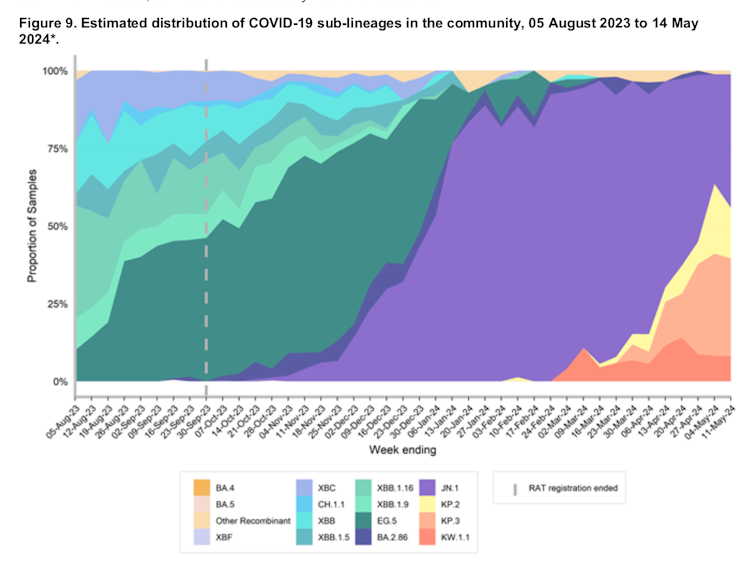Lara Herrero, Griffith University
We’ve now been living with COVID for well over four years. Although there’s still much to learn about SARS-CoV-2 (the virus that causes COVID) at least one thing seems clear: it’s here to stay.
From the original Wuhan variant, to Delta, to Omicron, and several others in between, the virus has continued to evolve.
New variants have driven repeated waves of infection and challenged doctors and scientists seeking to understand this changing virus’ behaviour.
Now, we are faced with a new group of variants, the so-called “FLiRT” variants, which appear to be contributing to a rising wave of COVID infections around Australia and elsewhere. So where have they come from, and are they cause for concern?
A descendant of Omicron
The FLiRT variants are a group of subvariants of JN.1 from the Omicron lineage.
JN.1 was detected in August 2023 and declared a variant of interest by the World Health Organization in December 2023. By early 2024, it had become the most dominant variant in Australia and much of the rest of the world, driving large waves of infections.
As new variants emerge, scientists work hard to try to understand their potential impact. This includes sequencing their genes and assessing their potential to transmit, infect and cause disease.
In late 2023 scientists detected a range of subvariants of JN.1 in wastewater in the United States. Since then, these JN.1 subvariants, including KP.1.1, KP.2 and KP.3, have popped up and become more common around the world.
But why the name FLiRT? Sequencing of these subvariants revealed a number of new mutations in the virus’ spike protein, including F456L, V1104L and R346T. The name FLiRT was coined by combining the letters in these mutations.

The spike protein is a crucial protein on the surface of SARS-CoV-2 that gives the virus its spiky shape and which it uses to attach to our cells. Amino acids are the basic building blocks that combine together to form proteins and the spike protein is 1273 amino acids long.
The numbers refer to the location of the mutations in the spike protein, while the letters designate the amino acid mutation. So, for example, F456L denotes a change from F (an amino acid called phenylalanine) to L (the amino acid leucine) at position 456.
What do we know about FLiRT’s characteristics?
The regions of the spike protein where the mutations have been found are important for two main reasons. The first is antibody binding, which influences the degree to which the immune system can recognise and neutralise the virus. The second is virus binding to host cells, which is required to cause infection.
These factors explain why some experts have suggested the FLiRT subvariants may be more transmissible than earlier COVID variants.
There are also very early suggestions that the FLiRT subvariants could evade immunity from prior infections and vaccination better than the parental JN.1 variant. However, this research is yet to be peer-reviewed (independently verified by other researchers).
In more positive news, there’s no evidence the FLiRT variants cause more severe disease than earlier variants. Still, that doesn’t mean catching a COVID infection driven by FLiRT is risk free.
Overall though, it’s very early days in terms of published research on these new FLiRT subvariants. We will need peer-reviewed data to understand more about FLiRT’s characteristics.
The rise of FLiRT
In the US, FLiRT has overtaken the original JN.1 variant as the dominant strain. The latest data from the US suggests the original JN.1 is making up less than 16 per cent of cases.
While the FLiRT subvariants were detected in Australia more recently, they appear to be gaining traction. For example, NSW Health data up to mid-May showed the proportion of KP.2 and KP.3 samples was continuing to increase.

In other parts of the world, such as the United Kingdom, the FLiRT subvariants are similarly on the rise.
In Australia, as temperatures continue to drop, and we head into the winter months, respiratory viruses commonly increase in circulation and case numbers peak.
So it is anticipated that the number of COVID cases will rise. And with the FLiRT subvariants showing evidence of increased ‘fitness’, meaning they present a stronger challenge against our body’s immune defences, it’s possible they will soon take over as the dominant subvariants circulating in Australia.
How can I stay protected?
As the FLiRT variants are descended from Omicron, the current booster on offer in Australia, against Omicron XBB.1.5, is likely to offer substantial protection. Although it’s not guaranteed to stop you becoming infected, COVID vaccines continue to provide strong protection against severe disease. So if you’re eligible, consider getting a booster to protect yourself this winter.
SARS-CoV-2 is now an endemic virus, meaning it will continue to circulate around the world. To do this, the virus mutates – usually only slightly – to survive.
The new FLiRT subvariants are excellent examples of this, where the virus mutates enough to continue to circulate and cause disease. So far there is no suggestion these subvariants are causing more severe illness. It’s more likely they will cause people to catch COVID yet again.
While the information we have at this stage doesn’t give us significant cause for concern about the FLiRT variants specifically, we are nonetheless facing rising COVID infections once more. And we know people who are older or vulnerable, for example due to medical conditions that compromise their immune system, continue to be at greater risk.
Lara Herrero, Research Leader in Virology and Infectious Disease, Griffith University
This article is republished from The Conversation under a Creative Commons licence. Read the original article.
Have you had COVID in the latest round? Why not share your experience in the comments section below?
Also read: COVID still killing far more than flu, data shows


Currently sitting at home weathering my way through my second ever bout of Covid. Which I now appear to have passed on to my wife and daughter – sorry!
Fortunately I am eligible for free anti-virals, which are making a difference.
Ironically, when I had my annual flu jab a couple of weeks ago, my doctor asked me if I wanted to have a Covid booster at the same time, as my last one was about 2 years ago. Obviously I should have said Yes!!!